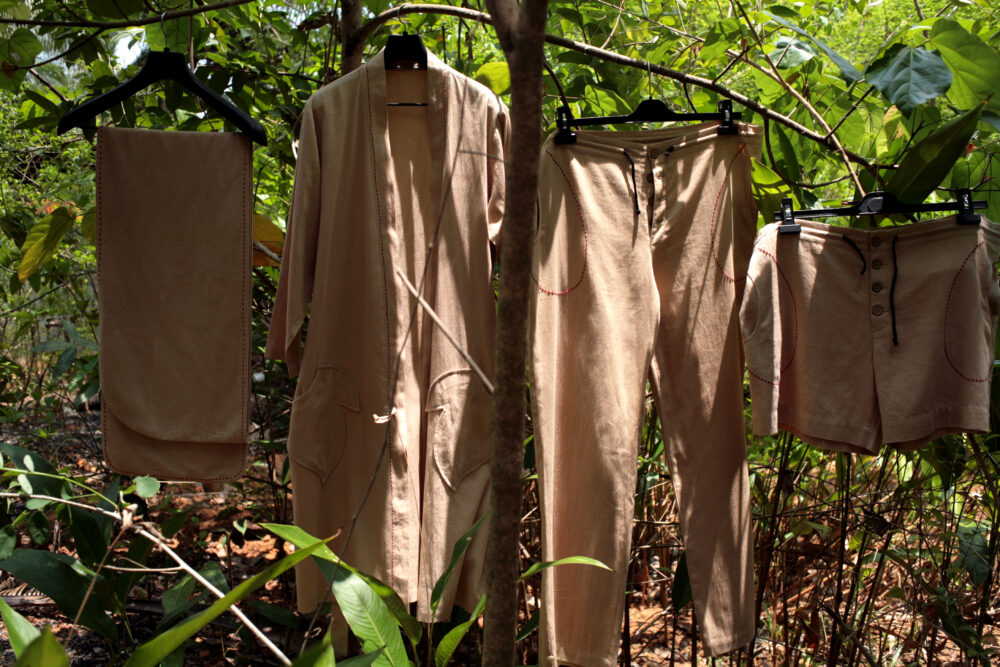Ayurganic: A meditative foray into conscious Ayurvedic fashion

Since the 80s, design duo comprising Frenchman Didier Lecoanet and Indo-German Hemant Sagar have been enthralling the world with their couture and ready-to-wear fashion. What inspired them to launch Ayurganic, a conscious line of premium leisure wear, rooted in the principles of Ayurveda? BeejLiving travels to Kerala to understand the vision and journey of Ayurganic, from pale cotton bales to breathable garments that restore balance and heal the body
When Hemant Sagar was a 15-year-old boy visiting Germany, he came across a tree stump outside someone’s home. Besides the stub was graffiti sprayed on the wall, a fitting response to the hack job: ‘tree murderer.’ “That sparked something in me,” says the Indo-German designer, with a snap of his fingers. “I became fascinated by the concept of nature and conservation, and how life surrounds us,” he says.

The beginning of Ayurganic
When he and Lecoanet moved to India a few decades later, they began their search for a craft form with an Indian ethos. A team member stumbled upon Ayurvastra, the art of dyeing clothes in medicinal botanicals. It was sage Agasthya, the father of Siddha, who created Ayurvastra. This branch of Ayurveda triggered in them the idea of creating a line of organic, herb infused (Ayur) clothing (Vastra) that is breathable, sustainable and aligned with earth. Lecoanet and Sagar took these centuries old principles and applied them to contemporary fashion with Ayurganic, a clothing movement with a spiritual, sustainable and scientific genome.

Ayurganic has completed nearly a decade since, though it was first conceived by
them around 18 years ago. The label uses GOTS certified cotton that goes
through the Ayurvastra process of herbal dyeing, before it is shaped into comfy
leisure wear at the atelier in Delhi.

Discovering Ayurvastra
A motley crew of journalists are sitting in Ayurganic’s Ayurvastra facility in Balaramapuram. A small town in Kerala’s Thiruvananthapuram district, Balaramapuram is famous for producing traditional textiles. This tiny facility lies at the fringes of the magical Agasthyamala Biosphere Reserve, straddling the cusp of Kerala and Tamil Nadu. The space is a Wunderkammer of curiosities carried forth from 5,000 years ago. Ayurveda permeates every pore of life here. The bricks of this tiny dwelling have been soaked in herbs. The walls are slathered with sandalwood paste, a natural mosquito repellent. The almirahs, made from anti-bacterial neem wood, are laden with bales of loosely wrapped cloth, yoga mats, poultices, and even coir slippers.

Mr Rajan, the chief technician of this Handloom Weavers’ Development Society, a cooperative, is the custodian of his family legacy of Ayurvastra, creating textiles and clothing rooted in Ayurveda. The 10th generation family member involved in this, he and his family and the natives collect herbs from the reserve, over 1,200 specimens. A seemingly infinite combination of herbs can be used as a panacea for all that ails you. A decoction to help you quit smoking? Check. To help you sleep? Check. To build immunity? Check.

Looking Inwards
Hemant regales the Ayurganic story. A pedestal fan whirs in the background, keeping us cool on this hot sticky April day. “Clothes with spirituality,” ruminates the designer. Along with Lecoanet, he runs Lecoanet Hemant, the Couture Line and Genes Lecoanet Hemant, their ready-to-wear line. “Everything we had done in the world of fashion until then focused on the external world – it was very bombastic. Our clothes were about demonstration, and never about feelings. Ayurganic is a revolution”

Ayurvastra was just one of the traditions Rajan’s ancestors nurtured. For instance, they used to weave turmeric root based fibers to make textiles favoured by royalty, but it is an art form lost in the annals of history. Rajan holds out a sepia-toned GOTS cotton fabric that has been dyed in Ayurganic’s unique herb blend, a faint fragrance of roots and herbs wafting from it. The fabric will be transported to the Ayurganic atelier in Gurugram.

Discovering the process
We move to the foyer. In tiny clay bowls, a few of the 50 herbs which make the Ayurganic medicinal dye are laid out. One is Bibhitaki, one third of triphala, a small fruit with a drying, astringent effect. Next to it is a bowl of dried and chopped vetiver – a stress reliever. The collection also includes chips of white sandalwood – the age defying skin nourisher – and red slivers of nut mace – used for treating stomach ailments. All these combined together impart an overall sense of well being when one wears the clothes.

The process is thoroughly detailed, the nuances a part of Rajan’s DNA. It’s a rhythmic process in sync with nature. The GOTS cotton is cleaned with fresh water, dried and then treated with oils and a decoction of milk and urine from the gentle, herb-fed bovine population. Then gummed with crystallised aloe vera, it is boiled in a concoction of herbs, for at least six hours over a wood fire, fed by trees locally grown in the area, be it neem, mango wood and more. The fire is stoked till the dye firmly steeps in to every fibre of the cloth. Depending on the season, it is washed in fresh well water, fed from the Neyyer River on the premises, or is taken to the actual river if the sun is high in the sky. Then the fabric is hung to dry in a shed for two weeks, after which it emerges as a healer of ailments, fabric with a soul.

Under the shade of a jackfruit tree
Over lunch at the workshop, under the shade of jackfruit trees and an artfully made tailor bird nest, we sup on delicious appam with vegetable stew, rice and kerala paratas washed down with copious amounts of flavoured lassis – mango, pineapple and grape. As we savour the food, Hemant says, “With Ayurganic, we wanted to build a bridge between the past and the future, between India and the world.” The collection is eclectic – yoga mats, eye masks, robes, hoodie kurtas, pants and pajamas, skirts and more. For the duo, it was imperative to embed principles of circularity in the brand. “The collection is actually 100% ecological, because everything, including the label, the threads and the buttons are recyclable. I even encourage people, if they don’t want to wear it anymore, to bury it in the garden to decompose. That’s how I imagine these clothes to finish their life cycle,” he says, as we ready to go back to our hotel on Poovar Island.

The final rinse
With the early onset of cyclonic weather, a light drizzle falls the next morning as we wend our way to the Neyyer River. Here we will witness one of the most fascinating steps in the layered process of creating Ayurvastra. After a short bus ride, we arrive in the southern district of Thirvananthapuram, Aruvippuram, a town famed for the Siva temple consecrated by social reformer and saint Sri Narayana Guru.

I’m standing on a rocky outcrop at the edge of the Neyyer River. We’re at the edge of the Agasthyamala Biosphere Reserve, the magical ancient forest, a natural repository of healing botanicals. Mr Rajan is standing ankle deep in the river, washing swathes of the herb-infused, sepia-toned fabric he dyed yesterday before our eyes in the river, the residual grist becoming potent food for the fish. It’s an enchanted scene. The cloth billows over the gentle cataract before he lays it out on the rocks to dry in the sun. We linger on the river banks, dipping our toes and fingers in the sweet river water, what it is colloquially known as.

Looking ahead
In the evening, under the setting sun, Hemant tells the future of design does not imply creating beautiful fashion only, but also discovering new technologies and innovating. Even creating Ayurganic, he says, is a semi-industrial process, where the GOTS Cotton is produced on the power loom and the process of dyeing the fabric, led by Mr. Rajan, is artisanal. A pragmatic approach to ensure longevity of the garment.

I wonder why haven’t more labels experimented with the concept of Ayurvastra. “It is a mystery to me. Ayurganic is really thinking out of the box. It’s sad that our traditions are being forgotten.” In the future, he is contemplating using mineral dyes and creating stretchable yoga wear. For him, this whole journey has been rediscovering peace, by regarding the body as a sacred temple, an enriching path which has seen them distill 5,000 years of tradition in to a short period of a decade. “Ayurganic is our way of coming home.”
Photographs: Sagar Ahuja and Neeti Mehra


